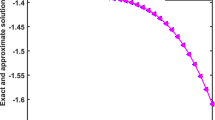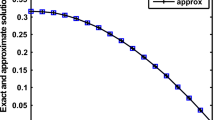Abstract
The boundary knot method (BKM) is a boundary-type meshfree method. Only non-singular general solutions are used during the whole solution procedures. The effective condition number (ECN), which depends on the right-hand side vector of a linear system, is considered as an alternative criterion to the traditional condition number. In this paper, the effective condition number is used to help determine the position and distribution of the collocation points as well as the quasi-optimal collocation point numbers. During the solution process, we propose an NMN-search algorithm. Numerical examples show that the ECN is reliable to measure the feasibility of the BKM.
Similar content being viewed by others
References
Chen J T, Lee Y T, Chen I L, et al. Mathematical analysis and treatment for the true and spurious eigenequations of circular plates by the meshless method using radial basis function [J]. Journal of the Chinese Institute of Engineers, 2004, 27(4): 547–561.
Bui T Q, Nguyen M N, Zhang C Z. An efficient meshfree method for vibration analysis of laminated composite plates [J]. Computational Mechanics, 2011, 48(2): 175–193.
Liu Y J, Mukherjee S, Nishimura N, et al. Recent advances and emerging applications of the boundary element method [J]. ASME Applied Mechanics Reviews, 2011, 64(5): 1–38.
Gu Y, Chen W, Qu W Z, et al. Two general algorithms for nearly singular integrals in two dimensional anisotropic boundary element method [J]. Computational Mechanics, 2014, 53(6): 1223–1234.
Li J, Huang Y, Yang W. Mathematical analysis and finite element simulation of a magnetized ferrite model [J]. Journal of Computational and Applied Mathematics, 2016, 292(1): 279–291.
Khan W, Islam S, Ullah B. Analysis of meshless weak and strong formulations for boundary value problems [J]. Engineering Analysis with Boundary Elements, 2017, 80: 1–17.
Cheng Y M, Peng M J. Boundary element-free method for elastodynamics [J]. Science in China Series G, 2005, 48(6): 641–657.
Liu C S. A modified collocation Trefftz method for the inverse Cauchy problem of Laplace equation [J]. Engineering Analysis with Boundary Elements, 2008, 32: 778–785.
Gu Y, Gao H W, Chen W, et al. Fast-multipole accelerated singular boundary method for large-scale three-dimensional potential problems [J]. International Journal of Heat and Mass Transfer, 2015, 90: 291–301.
Lin J, Zhang C Z, Sun L L, et al. Simulation of seismic wave scattering by embedded cavities in an elastic half-plane using the novel singular boundary method [J]. Advances in Applied Mathematics and Mechanics, 2018, 10(2): 322–342.
Lin J, Reutskiy S Y, Lu J. A novel meshless method for fully nonlinear advection-diffusion-reaction problems to model transfer in anisotropic media [J]. Applied Mathematics and Computation, 2018, 339: 459–476.
Fairweather G, Karageorghis A. The method of fundamental solutions for elliptic boundary value problems [J]. Advances in Computational Mathematics, 1998, 9(1–2): 69–95.
Chen C S, Karageorghis A, Smyrlis Y S. The Method of Fundamental Solutions—A Meshless Method[M]. Atlanta: Dynamic Publishers, 2008.
Wang F Z, Chen W, Ling L. Combinations of the method of fundamental solutions for general inverse source identification problems [J]. Applied Mathematics and Computation, 2012, 219(3): 1173–1182.
Kang S W, Lee J M, Kang Y J. Vibration analysis of arbitrarily shaped membranes using non-dimensional dynamic influence function [J]. Journal of Sound and Vibration, 1996, 221(1): 117–132.
Chen J T, Kuo S R, Chen K H, et al. Comments on “Vibration analysis of arbitrary shaped membranes using nondimensional dynamic influence function” [J]. Journal of Sound and Vibration, 2000, 235(1): 156–171.
Chen J T, Chang M H, Chen K H, et al. The boundary collocation method with meshless concept for acoustic eigenanalysis of two-dimensional cavities using radial basis function [J]. Journal of Sound and Vibration, 2002, 257(4): 667–711.
Chen J T, Chang M H, Chung I L, et al. Comment on “Eigenmode analysis of arbitrarily shaped two-dimensional cavities by the method of point matching” [J. Acoust. Soc. Am. 107, 1153 (2000)][J]. Journal of the Acoustical Society of America, 2002, 11(1): 33–36.
Wang F Z, Zhang J. Numerical simulation of acoustic problems with high wavenumbers [J]. Applied Mathematics & Information Sciences, 2015, 9(2): 1011–1014.
Wang F Z, Zheng K H. Analysis of the boundary knot method for 3D Helmholtz-type problems [J]. Mathematical Problems in Engineering, 2014, 2014: 1–9.
Zheng K H, Ma H W. Combinations of the boundary knot method with analogy equation method for nonlinear problems [J]. CMES: Computer Modeling in Engineering and Sciences, 2012, 87(3): 225–238.
Jin B T, Zheng Y. Boundary knot method for the Cauchy problem associated with the inhomogeneous Helmholtz equation [J]. Engineering Analysis with Boundary Elements, 2005, 29(10): 925–935.
Zhang J Y, Wang F Z. Boundary knot method: An overview and some novel approaches [J]. CMES: Computer Modeling in Engineering and Sciences, 2012, 88(2): 141–154.
Wang F Z, Ling L, Chen W. Effective condition number for boundary knot method [J]. CMC: Computers, Materials, & Continua, 2009, 12(1): 57–70.
Ling L, Schaback R. Stable and convergent unsymmetric meshless collocation methods [J]. SIAM Journal on Numerical Analysis, 2008, 46(3): 1097–1115.
Ling L, Schaback R. An improved subspace selection algorithm for meshless collocation methods [J]. International Journal for Numerical Methods in Engineering, 2009, 80(13): 1623–1639.
Fornberg B, Larsson E, Wright G. A new class of oscillatory radial basis functions [J]. Computers & Mathematics with Applications, 2006, 51(8): 1209–1222.
Drombosky T W, Meyer A L, Ling L. Applicability of the method of fundamental solutions [J]. Engineering Analysis with Boundary Elements, 2009, 33: 637–643.
Li Z C, Huang H T, Chen J T, et al. Effective condition number and its applications [J]. Computing, 2010, 89(1–2): 87–112.
Li Z C, Huang G T, Wei Y M, et al. Effect Condition Number for Numerical Partial Differential Equations [M]. Second Edition. Beijing: Science Press, 2015(Ch).
Carlos J S A. On the choice of source points in the method of fundamental solutions [J]. Engineering Analysis with Boundary Elements, 2009, 33(12): 1348–1361.
Wong K Y, Ling L. Optimality of the method of fundamental solutions [J]. Engineering Analysis with Boundary Elements, 2011, 35(1): 42–46.
Wang F Z, Chen W, Jiang X R. Investigation of regularized techniques for boundary knot method [J]. International Journal for Numerical Methods in Biomedical Engineering, 2010, 26(12): 1868–1877.
Ma H W, Wang F Z. New investigations into the boundary knot method for inverse problems of Helmholtz equation [J]. Journal of the Chinese Institute of Engineers, 2016, 39(4): 455–460.
Author information
Authors and Affiliations
Corresponding author
Additional information
Foundation item: Supported by the Natural Science Foundation of Anhui Province (1908085QA09) and Higher Education Department of the Ministry of Education (201802358008)
Rights and permissions
About this article
Cite this article
Wang, F., Zheng, K., Li, C. et al. Optimality of the Boundary Knot Method for Numerical Solutions of 2D Helmholtz-Type Equations. Wuhan Univ. J. Nat. Sci. 24, 314–320 (2019). https://doi.org/10.1007/s11859-019-1402-x
Received:
Published:
Issue Date:
DOI: https://doi.org/10.1007/s11859-019-1402-x




